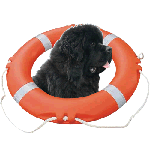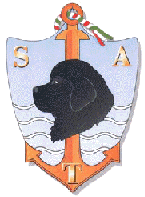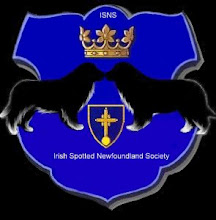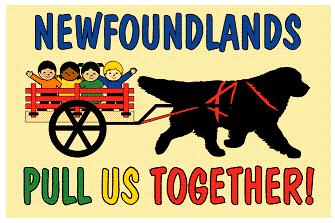Wednesday, September 29, 2021
When We Two Parted
"If I should meet thee -
After long years -
How should I greet thee? –
With silence and tears."
(Lord Byron)
Saturday, September 18, 2021
The Newfie Beer
(ST. JOHN'S, N.L.)
"India Beer has been a staple of the downtown St. John's bar scene for a long time. Brewed and distributed exclusively in Newfoundland and Labrador, its iconic logo features a Newfoundland dog above the tagline 'Man's Best Friend.'
Jason Hull, area sales manager for Molson in Atlantic Canada, reckons India has plenty of friends in St. John's, estimating 80 per cent of the lager’s sales are in Newfoundland and Labrador's capital city.
'We never really pushed it as a company,' said Hull, who has worked with Molson since 1999 and can recall how it was embraced back then as a brand by the local arts community and other folks in the downtown scene.
'We never hid that it was a Molson product or anything, but people just really love the history behind it — the fact that it's made here in Newfoundland and Labrador, and it just resonates with that group.'
First brewed by the Newfoundland Brewing Co. in the late 1800s, India Beer found a new home with Molson in the 1960s when it acquired the independent brewery.
For a long time, Molson and Labatt products were just about the only options in town when it came to beer, but the blossoming craft brewing industry has changed the landscape dramatically. Local beer drinkers like to try all kinds of style, with India pale ales (IPAs) proving to be especially popular nowadays.
'Certainly, there's been an explosion of craft products across North America and in Newfoundland and Labrador," Hull said. "We see that (IPA) is the Number One style out there.'
With that in mind, Molson is lending the India name and logo to a new beer brewed exclusively out of its Circular Road brewery in St. John's. The India Beer IPA, a session IPA with five per cent alcohol by volume, was released in stores this past week.
'It was really just to give our India drinkers a little different flavour out there,' Hull explained. 'We have lots (of IPAs) in our portfolio. We can get beers from B.C., get beers from anywhere we want and get an IPA. But there was something about having it made on Circular Road and putting the India name on it that made it kind of special for us and the people at the brewery.'
The Newfoundland Brewing Co. did have its own IPA decades ago, but it's not serving as a direct inspiration for the new brew’s recipe. Hull said the India Beer IPA has a hazy look and tropical notes in its taste, making use of Citra, Mosaic and El Dorado hops.
'It’s very sessionable,' Hull said. 'It’s for someone that wants to sip on a couple of them. It’s pretty easy drinking.'
The idea for producing an India-branded IPA came about a year ago.
'We just thought we have a lot of drinkers out there that like India, that like other Molson products, and we just wanted to open up the offering to them really and show them what we have ... We're known obviously for our mainstream beers ... we can put out a really good IPA as well if they're looking for one from us.'
India Beer IPA is available in 473-mililitre pint cans and as an eight-pack of 355-millilitre cans. It's also available on tap at select locations."
Saturday, September 11, 2021
The Canine Heroes Of September 11
(www.AKC.org)
"On first glance, this picture, from 2012, is one of unbearable sweetness. Two Golden Retrievers are standing together, one with a gray muzzle, the other a puppy, both wearing vests signifying that they are working dogs.
The older dog is Bretagne, one of the heroes of Ground Zero. Nearly 15 years after the event, she was still making headlines. In August 2015, media carried the story of a happy occasion—her 16th birthday, in which she and her handler Denise Corliss, members of Texas Task Force 1, were feted in New York City. In June 2016, sadder headlines told of her death, just shy of the great old age of 17.
The puppy in the picture is also Bretagne, named in honor of the 9/11 sniffing celebrity. She is one small part of the legacy of Bretagne and all the other dogs who helped through those dark days, whether they were searching the ruins or easing unimaginable grief.
Young Bretagne, trained to detect blood sugar fluctuations in a diabetic patient, is a graduate of a training school—the Penn Vet Working Dog Center. This training school is the brainchild of Dr. Cynthia M. Otto, a veterinarian who worked at Ground Zero.
Otto says that the work of the dogs in that terrible time made her facility possible.
Sniffer dogs had been around for decades, but the public had little understanding of what they could do. 'There was some sense that they might be able to find a lost Boy Scout in the woods but nothing of the scope and impact of a national disaster [even though they had a critical role in the Oklahoma City bombing and several natural disasters],' says Otto.
Media coverage of 9/11 focused on the dogs as the one 'ray of sunshine' in a bleak landscape, she says.
Images of these dogs working tirelessly, doing whatever was needed to get the job done, captured hearts and minds all over the world. Photos, such as the iconic one of Golden Retriever Riley of FEMA’s Pennsylvania Task Force 1, moved people to action.
Otto says that many dog owners were inspired to pursue search-and-rescue certification because of those images.
The performance of the dogs on 9/11 also sparked serious study of the effects of this kind of work on canine bodies and minds, Otto says. “We were able to conduct our longitudinal study of the dogs as a result of the generous funding of the AKC Canine Health Foundation.”
Press coverage, she says, also gave some search-dog training organizations a much-needed financial boost.
Super Noses?:
One of those organizations is the nonprofit National Disaster Search Dog Foundation, a group founded in 1995 by a retired teacher, Wilma Melville.
After her first deployment—the Oklahoma City bombing, in 1995—Melville recognized a need for more dogs specifically trained for this kind of work and founded the NSDF. The organization scours shelters, looking for dogs with search and rescue potential, and prepares them for jobs with fire departments. The training costs about $10,000. NSDF provides the dogs free of charge.
'Most people in this country had never heard of disaster search dogs [before 9/11],' says NSDF Executive Director Debra Tosch. When the news media started focusing on the dogs at Ground Zero, she says, 'public knowledge really exploded.
Tosch, and her SDF-trained black Labrador Retriever, Abby, were among the FEMA-certified canine search specialists, part of California Task Force 1, at the World Trade Center.
About 300 search teams, she estimated, responded. Only about 100 were prepared for a disaster of monstrous proportions in a major city. Many were wilderness search and rescue dogs, experts at finding people missing in the woods. They could not cope with the enormous mound of twisted metal, glass, and smoldering rubble and the urban noises.
Tosch says that some television coverage listed NSDF’s phone number. Donations started to pour in. 'We had this influx of funding right after the World Trade Center,' Tosch says. The support and publicity helped make Melville’s 20-year dream—the National Training Center, slated to open on September 24—a reality. It’s designed to give canine candidates the opportunity to practice on a variety of simulated disaster sites.
Soothing Souls:
The notion that dogs have the power to ease human emotional suffering is not new. Anyone who’s cried in the presence of a canine companion knows that. Smoky, a 4-pound Yorkshire Terrier, is credited with being the first therapy dog, cheering wounded soldiers in hospitals on the islands around New Guinea during World War II.
Dog trainer Cindy Ehlers first recognized the power of therapy dogs after the May 21, 1998, Thurston High School shooting, in Springfield, Oregon. She accompanied one of the first therapy dogs to work with the Red Cross in a disaster and one of the first to be certified for crisis-response.
After that experience, Ehlers got a Keeshond puppy she named Tikva, and trained her for crisis-response work. She also started an organization that is today the HOPE Animal-Assisted Crisis Response, in Eugene, Oregon.
On 9/11, Ehlers and Tikva traveled to New York. Dealing with such enormous waves of grief, fear, and confusion goes way beyond what is required of a therapy dog who visits hospitals and nursing homes. Ehlers says she saw some become too stressed to work.
Most teams stayed at the Family Assistance Centers, helping the relatives of the dead and missing. Red Cross mental-health experts saw that workers were not talking to the human therapists, and thought maybe they would talk to the dogs. Tikva, because of her crisis-relief training, became one of the few dogs who worked at Ground Zero helping the responders. Her preparation for working in this environment, as well as her cute looks, rock-solid temperament, and unusual breed, made her ideal for taking minds off the horror, if just for a few moments.
Ehlers says that that was where these four-legged therapists earned the sobriquet that they are known by now. 'A firefighter called up V-Mat [Veterinary Medical Assistance Teams] after we left and said, ‘Where are those comfort dogs? They’re the only thing that helps me get through the day.’
Growing Need For Therapy Dogs:
A new era for therapy dogs opened on 9/11, says Ursula Kempe, president of Therapy Dogs International, which she co-founded in the mid-1970s. TDI sent 100 teams to New York, where they worked at the Family Assistance Center on Pier 94 and 50 at the Pentagon. They spent about four weeks there. Kempe says that most of the dogs rose to the challenge, but some could not handle it.
'While this was still going on, I called a meeting at TDI and asked everyone who was involved if they wanted to come. We all realized—really there was absolutely no dissention—we are not prepared for that, as therapy-dog handlers.'
TDI tightened its criteria, requiring additional preparation for the human handlers and special certification for dogs participating in disaster relief. Since then, TDI teams have helped people cope with all kinds of disasters, from Hurricane Katrina to mass shootings to acts of terrorism.
Kempe says the way the world views working dogs has come a long way, but improvements are still needed. For example, only service dogs can travel by plane in the cabin with their owners. Kempe is trying to persuade airlines to allow disaster-relief comfort dogs to do the same. This one change, she says, would bring many more dogs to places where they are needed. Handlers are reluctant to transport their canine partners in baggage.
The Future of Working Dogs:
Otto believes that the need for dogs trained for all kinds of serious work is going to soar in the future, and more funding, facilities, and people willing to become handlers are desperately needed. Already, given all that they do, she says, “there is a shortage of dogs and funds to support them as well as the research to keep them healthy and performing optimally.”
The experts also say that there is no way to predict what the future needs will be and how dogs will contribute to keeping us safe and helping people recover from a horror like the events of 15 years ago.
'People are realizing all of the different ways we can use these K-9s,' Tosch says. 'We’re only limited by our imagination.'”
Wednesday, September 1, 2021
Subscribe to:
Posts (Atom)

















































